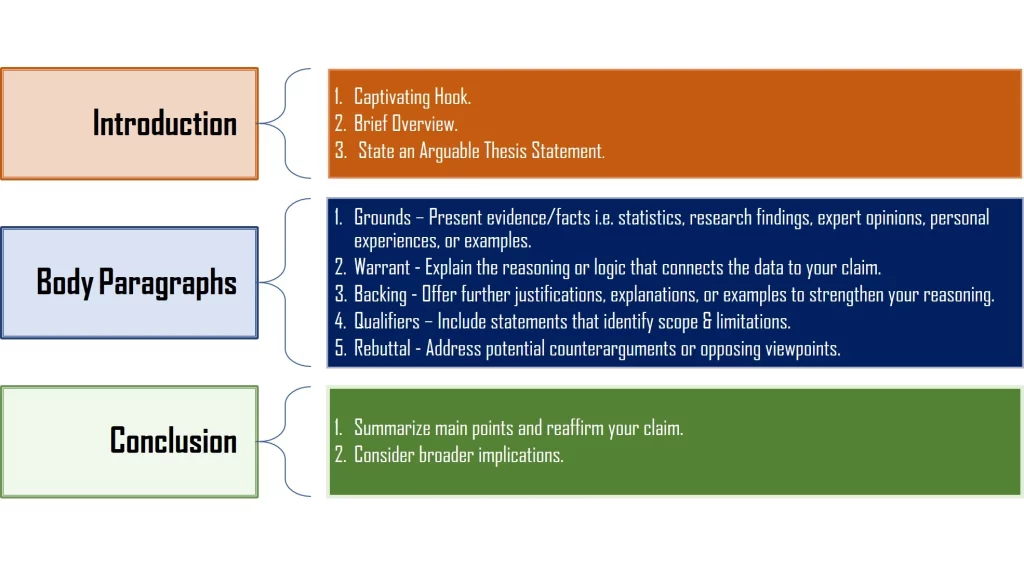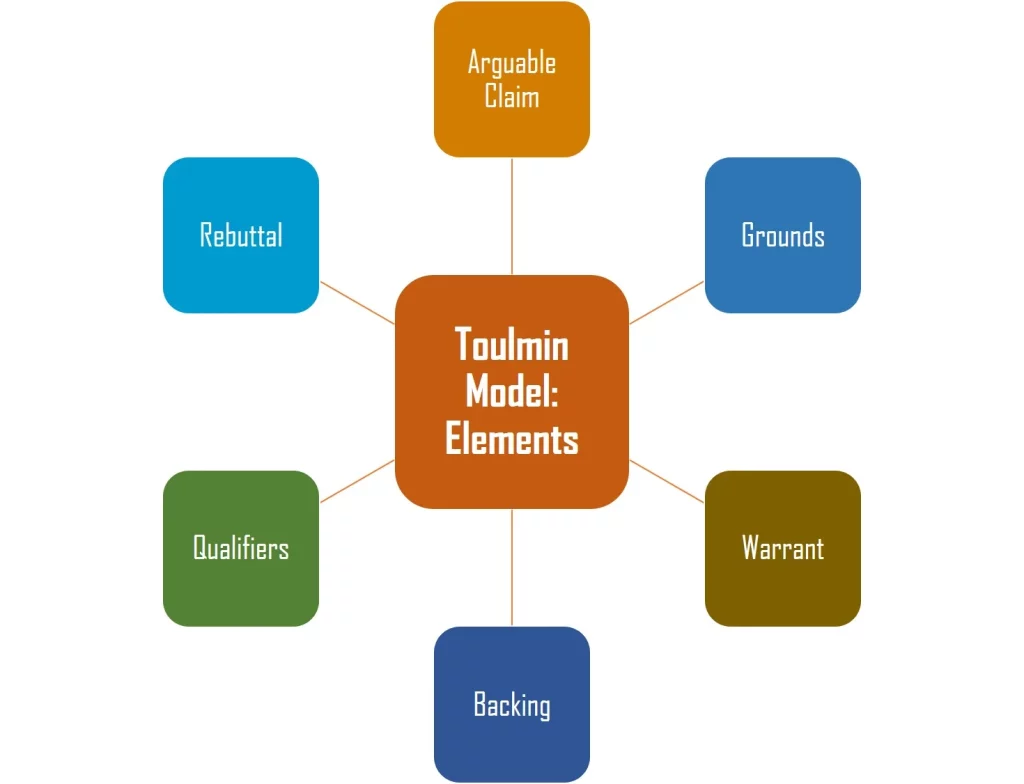- 5-Paragraph Argumentative Essay on Euthanasia
- Aristotelian Argument Essay on Marijuana
- Toulmin Argument Essay on Artificial Intelligence
- Rogerian Argument Essay on Gun Control
- Rebuttal Argument Essay on Renewable Energy
- Sample Historical Argument Essay on the Industrial Revolution
- Literary Argument Essay on 'The Cask of Amontillado'
- Persuasive Argument Essay: Financial Literacy
- Persuasive Argument Essay: Social Media and Politics
- Proposal Argument Essay on Reusable Containers
- Proposal Argument Essay on Workplace Wellness
- Rhetorical Evaluation Argument Essay: MLK's "I Have a Dream"
- Literary Evaluative Argument Essay: "To Kill a Mockingbird"
- Narrative Argument Essay on Resilience
- Definition Argument Essay on Privacy
- Causal Argument Essay on Education

A Toulmin argument is a type of argumentative structure developed by philosopher Stephen Toulmin in his book “The Uses of Argument.” It provides a framework for constructing and analyzing arguments by identifying the key components and their relationships. The Toulmin model is particularly useful for examining real-world arguments and determining their validity and effectiveness.
Here is a sample Toulmin argument essay for college students:
Sample Toulmin Argument Essay on Artificial Intelligence
Other than the Toulmin approach, argumentative essays can be formulated using the Rogerian argument or the Aristotelian/classical argument structure.
Key Elements of the Toulmin Model

The Toulmin model advocates for writing arguments based on 6 main elements: claim, grounds, warrant, backing, qualifiers, and rebuttal. Below is each in detail:
- Argumentative Claim: The main statement or proposition that the argument aims to support or prove. It represents the position the arguer wants the audience to accept.
- Grounds (Data or Evidence): The evidence or facts that support the claim. It can include statistics, research findings, expert opinions, personal experiences, or examples.
- Warrant: The reasoning or logic that connects the data to the claim. It explains why the evidence is relevant and supports the claim. The warrant often relies on general principles, values, or assumptions shared by the arguer and the audience.
- Backing: Additional support or evidence for the warrant. It provides further justification for the reasoning and helps strengthen the argument.
- Qualifiers: Statements that indicate the strength or scope of the claim. They acknowledge the limitations, exceptions, or conditions under which the claim may or may not hold true. Qualifiers can be words like “usually,” “probably,” “often,” “sometimes,” or “in most cases.”
- Rebuttal: Counterarguments or opposing viewpoints that challenge the claim. Including a rebuttal demonstrates that the arguer has considered alternative perspectives and is prepared to address potential objections.
By breaking down an argument into these components, the Toulmin model provides a systematic approach to understanding and evaluating the strengths and weaknesses of an argument. It encourages the use of evidence, reasoning, and acknowledgment of alternative viewpoints to create more robust and persuasive arguments.
An additional component can be the conclusion (the final outcome or resolution of the argument). It summarizes the main points and reaffirms the claim, considering the presented evidence and addressing potential counterarguments.
General Outline
- Introduction:
- Body Paragraphs:
- Evidence/Grounds:
- Warrant:
- Backing:
- Qualifiers:
- Rebuttal:
- Conclusion:
Remember to organize your essay logically and use clear, concise language. Each section should flow smoothly into the next, and your argument should be supported by solid evidence and reasoning throughout.
Additionally, make sure to use proper citations and references when citing sources. While it is common to address counterarguments in a separate section of the essay, you can also include counterarguments within the body paragraphs. Although a combination of writing techniques should be applied when writing an argumentative essay, constructing evaluative arguments is an integral part of the Toulmin model.
How to Write: Steps
- Identify the Issue or Topic: Choose a specific, debatable topic or issue to serve as the subject of your argument essay. It should be something that can be discussed, analyzed, and has different perspectives.
- Craft Your Claim: Develop a clear and concise claim or thesis statement that represents your main argument. This should be a statement that you want to prove or support in your essay.
- Identify Your Warrant: A warrant is the underlying assumption or principle that connects the evidence to the claim. Identify the warrant that justifies your claim and explain it in your essay.
- Gather Evidence: Collect relevant and credible evidence that supports your claim. This can include statistics, research findings, expert opinions, examples, anecdotes, and facts.
- Provide Backing: Backing is additional support or reasoning that strengthens your warrant. Explain why the warrant is valid and why the evidence supports it.
- Include Qualifiers: Qualifiers are words or phrases that indicate the strength or limitations of your argument. They acknowledge the possibility of exceptions or limitations to your claim. For example, you might use words like “usually,” “often,” “in most cases,” etc.
- Address Counterarguments: Consider potential counterarguments or opposing viewpoints. Anticipate objections to your claim and address them in your essay. Rebut these objections with evidence and reasoning.
- Organize Your Essay: Structure your essay with the Toulmin elements in mind. Typically, the essay will follow this pattern:
- Revise and Edit: Carefully review and revise your essay for clarity, coherence, and persuasiveness. Make sure that your argument is well-structured and that your evidence is effectively integrated.
- Finalize Your Essay: Check for proper formatting and citation style as required by your instructor or publication guidelines.
The Toulmin model provides a structured approach to argumentation by breaking down the elements of an argument, making it a powerful tool for constructing well-reasoned and evaluative essays.
Developing a Strong Thesis Statement
Here’s a template you can use to craft a suitable thesis statement for a Toulmin argument essay:
“This essay asserts that [claim/position] by presenting [evidence/reason 1], [evidence/reason 2], and [evidence/reason 3], ultimately establishing the validity and persuasiveness of [claim/position].”
Here is a discussion of this template:
- [Claim/Position]: Clearly state your main claim or position on the issue. Make sure it is specific and arguable.
- [Evidence/Reason 1], [Evidence/Reason 2], [Evidence/Reason 3]: Present the main points, evidence, or reasons that support your claim or position. These will serve as the backbone of your argument, with each point or reason warranting its own supporting paragraphs.
- [Validity and Persuasiveness of Claim/Position]: Indicate that your essay will demonstrate the validity and persuasiveness of your claim or position by providing evidence, examples, and logical reasoning.
Remember, the thesis statement in a Toulmin argument essay should provide a clear roadmap for your argument and indicate how you will build your case. Adapt this template to fit the specific topic and supporting points you will be presenting in your Toulmin argument essay.
Suitable Topics & Thesis Statements Examples
- Topic: Universal Healthcare:
Thesis Statement: “This essay asserts that universal healthcare is a fundamental right, as it ensures equal access to quality medical services, improves public health outcomes, and alleviates financial burdens on individuals.”
- Topic: School Uniforms:
Thesis Statement: “By examining the benefits of promoting discipline, reducing social inequalities, and enhancing a conducive learning environment, this essay supports the implementation of school uniform policies in educational institutions.”
- Topic: Capital Punishment:
Thesis Statement: “This essay argues against the use of capital punishment, as it fails to deter crime effectively, poses the risk of executing innocent individuals, and contradicts the principles of human rights and justice.”
- Topic: Legalization of Marijuana:
Thesis Statement: “By analyzing the economic benefits, addressing racial disparities in enforcement, and considering individual autonomy, this essay supports the legalization and regulation of marijuana.”
- Topic: Online Privacy:
Thesis Statement: “This essay asserts that individuals’ online privacy rights must be protected through comprehensive legislation, effective data protection measures, and increased public awareness to safeguard personal information in the digital age.”
- Topic: Climate Change Policies:
Thesis Statement: “By recognizing the urgency of addressing climate change, this essay argues for the implementation of robust policies, including carbon pricing, renewable energy incentives, and international cooperation, to mitigate environmental degradation and promote sustainability.”
- Topic: Animal Rights:
Thesis Statement: “This essay advocates for the recognition and protection of animal rights, as sentient beings deserving ethical considerations, by promoting cruelty-free practices, banning animal testing, and enforcing stricter animal welfare laws.”
- Topic: Gun Control:
Thesis Statement: “By balancing individual rights with public safety, this essay argues for comprehensive gun control measures, including background checks, closing loopholes, and implementing stricter regulations, to reduce gun-related violence and promote responsible firearm ownership.”
- Topic: Affirmative Action:
Thesis Statement: “By acknowledging historical disadvantages and promoting equal opportunities, this essay supports the continued implementation of affirmative action policies to address systemic inequalities and foster diversity in education and employment.”
- Topic: Renewable Energy Transition:
Thesis Statement: “This essay asserts that transitioning to renewable energy sources is essential for combating climate change, reducing dependence on fossil fuels, and creating sustainable economic opportunities through job growth and technological innovation.”
- Topic: Gun Rights and Gun Control:
Thesis Statement: “This essay argues for a balanced approach to gun rights and gun control, advocating for responsible firearm ownership, background checks, and mental health evaluations, while respecting individuals’ constitutional rights.”
- Topic: Social Media and Mental Health:
Thesis Statement: “By examining the impact of excessive social media usage on mental health, this essay supports the need for promoting digital well-being, fostering healthy online habits, and raising awareness about potential risks and benefits.”
- Topic: Environmental Conservation and Economic Development:
Thesis Statement: “This essay asserts that environmental conservation and economic development can be achieved in harmony through sustainable practices, green technologies, and policies that promote both ecological integrity and economic growth.”
- Topic: Ethical Considerations of Genetic Engineering:
Thesis Statement: “By evaluating the ethical implications of genetic engineering, this essay argues for responsible research, regulatory oversight, and public engagement to address concerns regarding genetic manipulation while realizing the potential benefits.”
- Topic: Government Surveillance and Civil Liberties:
Thesis Statement: “This essay examines the balance between government surveillance and civil liberties, advocating for robust oversight, transparency, and judicial safeguards to protect privacy rights while ensuring national security.”
Remember, the key to writing a successful Toulmin argument essay is to effectively structure and support your argument by clearly articulating the claim, warrant, evidence, backing, qualifiers, and addressing counterarguments. Additionally, providing strong, credible evidence and considering the limitations of your argument are crucial for persuasiveness.
